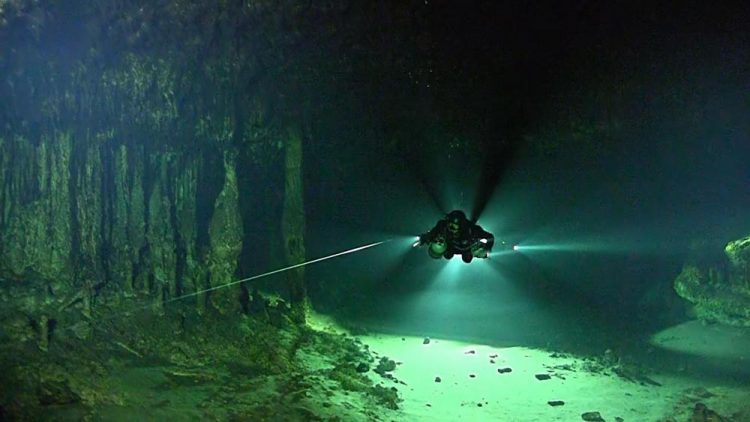Texas A&M-Galveston team finds cave organisms living off methane gas

Bil Phillips, cave explorer, who was also a member of the Texas A&M-led team uses a flashlight and line to navigate the underwater cave. Credit: HP Hartmann
David Brankovits, a student from Budapest, Hungary, who led the research for his Ph.D at Texas A&M-Galveston, and fellow researchers from Mexico, The Netherlands, Switzerland, the University of Alaska-Fairbanks and the U.S. Geological Survey, have had their work published in the current issue of Nature Communications.
The team examined flooded cave passages within the Ox Bel Ha cave network in the Yucatan where there is a mix of fresh and salt water. Methane in such caves tends to form naturally from surface vegetation and migrates through the limestone in deep waters of the cave network. They found that the methane gases in the area are an important food source for bacteria and other microbes that form the basis of the entire cave ecosystem.
The microbes consume both the methane in the water and other dissolved organic material produced in the overlying soils and permeable carbonate rock, and they form the basis of a food web that ranges from other tiny organisms to fairly large shrimp.
“Methane is the key – the cave organisms have to live off the methane gas, which caught us by surprise,” explains Brankovits.
“In the studied system, cave-adapted organisms exist where there is no sunlight and virtually all food sources are present in dissolved forms. Without the presence of microbes that can utilize methane and other dissolved energy sources, these animals could not live otherwise. Previous studies had shown that food came from vegetation or other materials in the forest that washed into the caves, but we found very little of that type of debris.”
Similar coastal cave ecosystems exist around the world. Brankovits says the next step is to do more research in similar cave systems found in the Bahamas, the Dominican Republic and other Caribbean locations.
“There are other dissolved organic materials like natural acids and alcohols, down there that we are just now learning about, and we need to explore them in more detail. The results could be surprising,” he notes.
Tom Iliffe, professor of marine biology at Texas A&M-Galveston and one of the most experienced cave divers in the world who was part of the research team, adds, “Providing a model for the basic function of this globally-distributed ecosystem is an important contribution to coastal groundwater ecology and establishes a baseline for evaluating how sea level rise, seaside touristic development and other stressors will impact the viability of these lightless, food-poor systems.”
###
The study was funded and supported by TAMU-CONACYT program, the U.S. Geological Survey and Moody Gardens Aquarium in Galveston.
Media Contact
All latest news from the category: Earth Sciences
Earth Sciences (also referred to as Geosciences), which deals with basic issues surrounding our planet, plays a vital role in the area of energy and raw materials supply.
Earth Sciences comprises subjects such as geology, geography, geological informatics, paleontology, mineralogy, petrography, crystallography, geophysics, geodesy, glaciology, cartography, photogrammetry, meteorology and seismology, early-warning systems, earthquake research and polar research.
Newest articles

Bringing bio-inspired robots to life
Nebraska researcher Eric Markvicka gets NSF CAREER Award to pursue manufacture of novel materials for soft robotics and stretchable electronics. Engineers are increasingly eager to develop robots that mimic the…

Bella moths use poison to attract mates
Scientists are closer to finding out how. Pyrrolizidine alkaloids are as bitter and toxic as they are hard to pronounce. They’re produced by several different types of plants and are…

AI tool creates ‘synthetic’ images of cells
…for enhanced microscopy analysis. Observing individual cells through microscopes can reveal a range of important cell biological phenomena that frequently play a role in human diseases, but the process of…





















